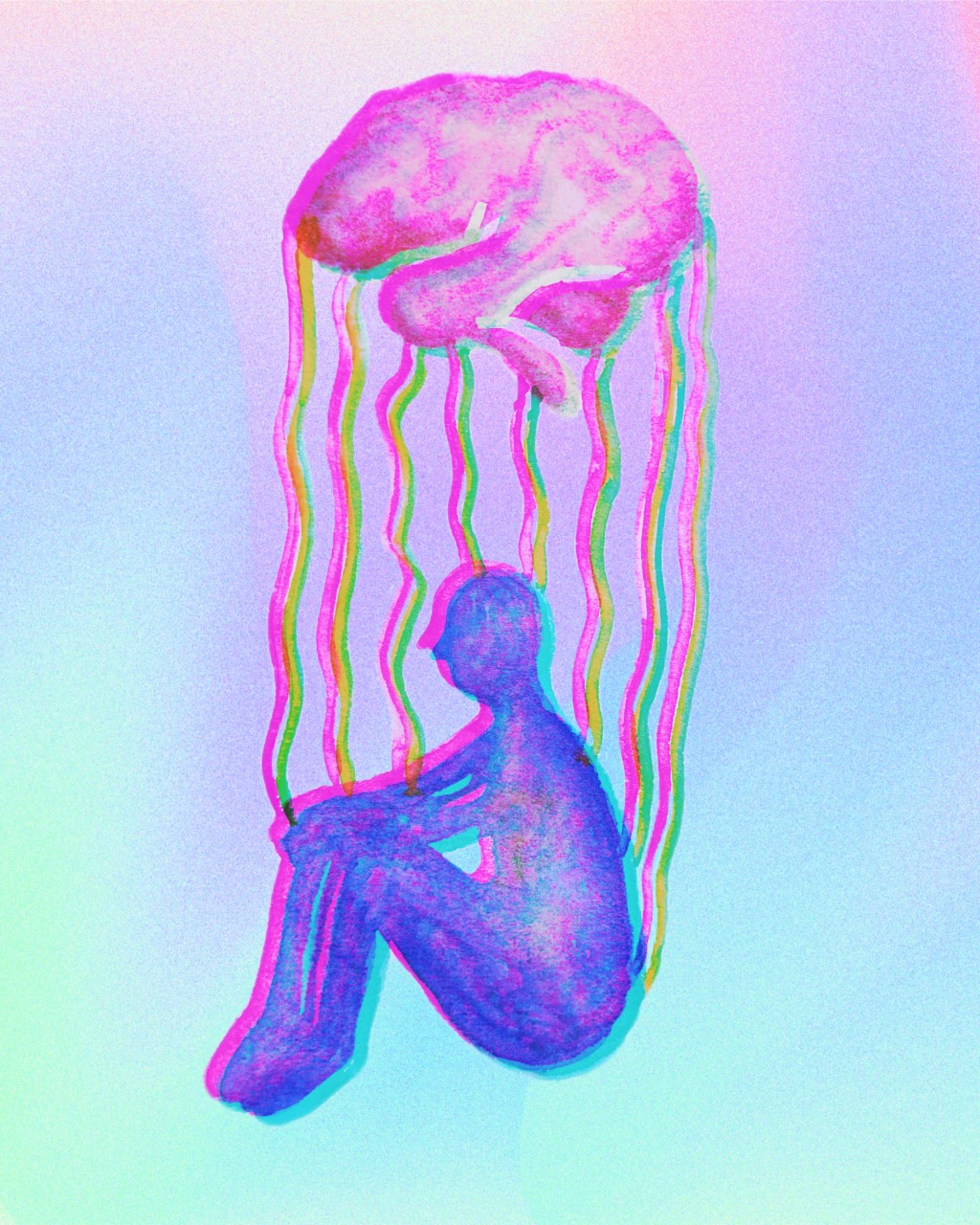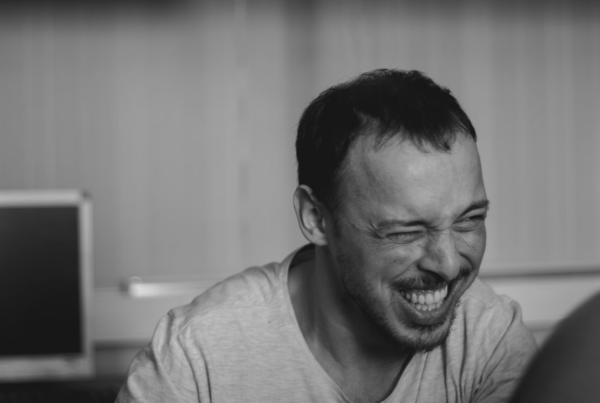

Illustration by Arianna Cavalli
In psychology, various theories of emotion propose the workings of this relationship. Surprisingly, the James-Lange theory (1884) states that we experience emotions in response to physiological changes. However, the physiologist Walter Bradford Cannon identified issues within the James-Lange theory, leading him to develop the Cannon-Bard theory (1927). Here, in this thalamic theory of emotion, Cannon explains that external stimuli trigger the neurons of the thalamic region, which give rise to the experience of emotion. Whilst the cortex controls the expression of emotion, physiology occurs independently yet simultaneously. Hence, whichever way you see it, the experience of our emotions and our bodily expressions are interdependent.
To understand the physiology of emotions, one must look at the functioning of the autonomic nervous system. The nervous system is the driver, made up of the sympathetic nervous system, the body’s accelerator, and the parasympathetic nervous system, the body’s brake. The sympathetic nervous system manages the alarm in our head when there is danger resulting in the fight-or-flight response. This system increases our heart rate as we feel fear or anxiety. The parasympathetic nervous system regulates bodily functions and is responsible for the rest-and-digest response. For example, it allows you to feel calm as you take long, deep breaths. Therefore, insight into the functioning of the nervous system helps us understand how our physiology influences emotional changes and thus fosters our awareness.
However, as of now, there are more elaborated theories of emotion which involve the cognitive perspective. Specifically, cognitive appraisal, which regards our perception of our environment, allowing us to interpret whether something is stressful or not. Thus, the appraisal theory of emotions (Roseman, 1996) focuses on the alignment between the individual’s appraisal of the event and their aim. Consistency results in positive emotions, and inconsistency, results in negative ones. More complex emotions such as grief, jealousy and regret are thought to be based on the perceived cause of the event. The component process model (Scherer, 2009) explains a person’s response by their perception of the relevance and effects of the event, their ability to cope with the consequences and the influence of the person’s self-concept. The current cognitive models show a relationship between cognition and emotion. According to these, we should acknowledge how the cognitive aspects of emotion materialise in the body and, ultimately, how the bodily elements of emotion are cognitive.
“Cultivating interoception is crucial as it provides the means to regulate emotion, manage stress, initiate motivation, access pleasure, and promote self-awareness.”
Now that we have more insight into how thoughts form emotions, we can explore how a shift from thinking to observing can make us aware of our senses. Of course, emotions readily change because they are short-lived bodily responses directed toward an object that calls for action. These unconscious processes can only be experienced consciously once we realise how we are affected by them, leading to an awareness of feelings. As Damasio’s theory of consciousness (2001) designates, emotions amount to the protoself, a basic level of awareness of the organism’s state, while feelings comprise the core consciousness. For this level of understanding, it is necessary to have interoception, which is the ability to sense the body’s internal state. So why is it essential to get in touch with our bodies? Cultivating interoception is crucial as it provides the means to regulate emotion, manage stress, initiate motivation, access pleasure, and promote self-awareness. Conversely, a lack of interoception is a central aspect of trauma and mental disorders (Van Der Kolk, 2015).
You may be asking yourself: How do I get in touch with my emotions and feel their bodily sensations? The practice of interoception may seem scary as it is obscure, and there is no clear answer. But do not worry, as there are practices to develop interoception, for example, the elements of yoga. The essence of yoga nourishes awareness of our body. Specifically, in the Western world, we focus on asana, the physical practice and postures, pranayama, the breathwork, and dhyana, the meditation. The mindfulness fostered during these practices allows us to understand how emotions are felt in our bodies and mind. For instance, the psoas muscle, which connects the mid and lower back to the inner thigh bone at the hip, illustrates how emotions are stored in the body. This muscle accumulates tension due to traumatic experiences that can be released through hip-opening poses; the release is accompanied by the expression of stored emotions (Trauma Conscious Yoga Institute, 2018).
“Yoga-based interventions show promising results for anxiety and depression.”
Michalsen et al. (2005) studied the effect of an intensive yoga program on distressed women. The results found significant improvement in perceived stress, cortisol levels, and pain relief for those who reported headaches and back pain from stress. Likewise, yoga-based interventions show promising results for anxiety (Kirkwood, 2005) and depression (Pilkington et al., 2005). However, it is necessary to conduct further studies with carefully constructed methodologies to show a distinct influence. In addition, studies investigating the effect of manipulated breathing patterns on emotional states show that the breathing patterns can indeed induce the desired emotional state (Philippot et al., 2002).
Lastly, an article highlights the effect of the central respiratory centre on the autonomic nervous system, additionally discussing studies which show that slow breathing techniques stimulate the parasympathetic nervous system (Russo et al., 2017). Now that we have looked at the physiological aspect of emotions, we can be sure of an influential relationship between bodily responses and emotions through the functioning of the autonomic nervous system. Furthermore, the cognitive element of emotion has shown how our thoughts form feelings. Not to mention how taking a step back from thinking and simply observing gives us better awareness. To conclude, when we feel, so do our bodies; both the experience and expression of emotion are unified within us, though many times, we accidentally disconnect. Therefore, take this moment as a reminder to tend to our body and ourselves to fully experience what it is to be alive. <<
References
-Cannon, W. B. (1927). The james-lange theory of emotions: A critical examination and an alternative theory. The American Journal of Psychology, 39(1/4), 106. https://doi.org/10.2307/1415404
-James, W. (1884). II.—what is an emotion ? Mind, os-IX(34), 188–205. https://doi.org/10.1093/mind/os-ix.34.188
-Kirkwood, G. (2005). Yoga for anxiety: A systematic review of the research evidence * commentary. British Journal of Sports Medicine, 39(12), 884–891. https://doi.org/10.1136/bjsm.2005.018069
-Michalsen, A., Grossman, P., Acil, A., Langhorst, J., Lüdtke, R., Esch, T., Stefano, G. B., & Dobos, G. J. (2005). Rapid stress reduction and anxiolysis among distressed women as a consequence of a three-month intensive yoga program. Medical science monitor : international medical journal of experimental and clinical research, 11(12), CR555–CR561.
-Parvizi, J. (2001). Consciousness and the brainstem. Cognition, 79(1-2), 135–160. https://doi.org/10.1016/s0010-0277(00)00127-x
-Philippot, P., Chapelle, G., & Blairy, S. (2002). Respiratory feedback in the generation of emotion. Cognition & Emotion, 16(5), 605–627. https://doi.org/10.1080/02699930143000392
-Pilkington, K., Kirkwood, G., Rampes, H., & Richardson, J. (2005). Yoga for depression: The research evidence. Journal of Affective Disorders, 89(1-3), 13–24. https://doi.org/10.1016/j.jad.2005.08.013
-The PSOAS MUSCLE: How it holds onto trauma and how to let it go, with yoga. Trauma Conscious Yoga Institute. (2018, October 21). Retrieved 2022, from https://traumaconsciousyoga.com/psoas/
-Roseman, I. J. (1996). Appraisal determinants of emotions: Constructing a more accurate and comprehensive theory. Cognition & Emotion, 10(3), 241–278. https://doi.org/10.1080/026999396380240
-Russo, M. A., Santarelli, D. M., & O’Rourke, D. (2017). The physiological effects of slow breathing in the healthy human. Breathe, 13(4), 298–309. https://doi.org/10.1183/20734735.009817
-Scherer, K. R. (2009). The dynamic architecture of emotion: Evidence for the component process model. Cognition & Emotion, 23(7), 1307–1351. https://doi.org/10.1080/02699930902928969
-Van Der Kolk, B. (2015). Losing Your Body, Losing Your Self. In The body keeps the score: Mind, brain and body in the transformation of trauma (pp. 102–121). essay, Penguin Books.
In psychology, various theories of emotion propose the workings of this relationship. Surprisingly, the James-Lange theory (1884) states that we experience emotions in response to physiological changes. However, the physiologist Walter Bradford Cannon identified issues within the James-Lange theory, leading him to develop the Cannon-Bard theory (1927). Here, in this thalamic theory of emotion, Cannon explains that external stimuli trigger the neurons of the thalamic region, which give rise to the experience of emotion. Whilst the cortex controls the expression of emotion, physiology occurs independently yet simultaneously. Hence, whichever way you see it, the experience of our emotions and our bodily expressions are interdependent.
To understand the physiology of emotions, one must look at the functioning of the autonomic nervous system. The nervous system is the driver, made up of the sympathetic nervous system, the body’s accelerator, and the parasympathetic nervous system, the body’s brake. The sympathetic nervous system manages the alarm in our head when there is danger resulting in the fight-or-flight response. This system increases our heart rate as we feel fear or anxiety. The parasympathetic nervous system regulates bodily functions and is responsible for the rest-and-digest response. For example, it allows you to feel calm as you take long, deep breaths. Therefore, insight into the functioning of the nervous system helps us understand how our physiology influences emotional changes and thus fosters our awareness.
However, as of now, there are more elaborated theories of emotion which involve the cognitive perspective. Specifically, cognitive appraisal, which regards our perception of our environment, allowing us to interpret whether something is stressful or not. Thus, the appraisal theory of emotions (Roseman, 1996) focuses on the alignment between the individual’s appraisal of the event and their aim. Consistency results in positive emotions, and inconsistency, results in negative ones. More complex emotions such as grief, jealousy and regret are thought to be based on the perceived cause of the event. The component process model (Scherer, 2009) explains a person’s response by their perception of the relevance and effects of the event, their ability to cope with the consequences and the influence of the person’s self-concept. The current cognitive models show a relationship between cognition and emotion. According to these, we should acknowledge how the cognitive aspects of emotion materialise in the body and, ultimately, how the bodily elements of emotion are cognitive.
“Cultivating interoception is crucial as it provides the means to regulate emotion, manage stress, initiate motivation, access pleasure, and promote self-awareness.”
Now that we have more insight into how thoughts form emotions, we can explore how a shift from thinking to observing can make us aware of our senses. Of course, emotions readily change because they are short-lived bodily responses directed toward an object that calls for action. These unconscious processes can only be experienced consciously once we realise how we are affected by them, leading to an awareness of feelings. As Damasio’s theory of consciousness (2001) designates, emotions amount to the protoself, a basic level of awareness of the organism’s state, while feelings comprise the core consciousness. For this level of understanding, it is necessary to have interoception, which is the ability to sense the body’s internal state. So why is it essential to get in touch with our bodies? Cultivating interoception is crucial as it provides the means to regulate emotion, manage stress, initiate motivation, access pleasure, and promote self-awareness. Conversely, a lack of interoception is a central aspect of trauma and mental disorders (Van Der Kolk, 2015).
You may be asking yourself: How do I get in touch with my emotions and feel their bodily sensations? The practice of interoception may seem scary as it is obscure, and there is no clear answer. But do not worry, as there are practices to develop interoception, for example, the elements of yoga. The essence of yoga nourishes awareness of our body. Specifically, in the Western world, we focus on asana, the physical practice and postures, pranayama, the breathwork, and dhyana, the meditation. The mindfulness fostered during these practices allows us to understand how emotions are felt in our bodies and mind. For instance, the psoas muscle, which connects the mid and lower back to the inner thigh bone at the hip, illustrates how emotions are stored in the body. This muscle accumulates tension due to traumatic experiences that can be released through hip-opening poses; the release is accompanied by the expression of stored emotions (Trauma Conscious Yoga Institute, 2018).
“Yoga-based interventions show promising results for anxiety and depression.”
Michalsen et al. (2005) studied the effect of an intensive yoga program on distressed women. The results found significant improvement in perceived stress, cortisol levels, and pain relief for those who reported headaches and back pain from stress. Likewise, yoga-based interventions show promising results for anxiety (Kirkwood, 2005) and depression (Pilkington et al., 2005). However, it is necessary to conduct further studies with carefully constructed methodologies to show a distinct influence. In addition, studies investigating the effect of manipulated breathing patterns on emotional states show that the breathing patterns can indeed induce the desired emotional state (Philippot et al., 2002).
Lastly, an article highlights the effect of the central respiratory centre on the autonomic nervous system, additionally discussing studies which show that slow breathing techniques stimulate the parasympathetic nervous system (Russo et al., 2017). Now that we have looked at the physiological aspect of emotions, we can be sure of an influential relationship between bodily responses and emotions through the functioning of the autonomic nervous system. Furthermore, the cognitive element of emotion has shown how our thoughts form feelings. Not to mention how taking a step back from thinking and simply observing gives us better awareness. To conclude, when we feel, so do our bodies; both the experience and expression of emotion are unified within us, though many times, we accidentally disconnect. Therefore, take this moment as a reminder to tend to our body and ourselves to fully experience what it is to be alive. <<



